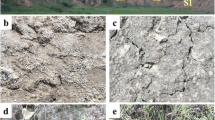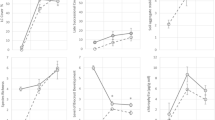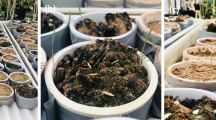Abstract
Aims
Biocrusts that form on topsoils contribute ecosystem services to drylands, and their loss under anthropogenic pressure has negative ecological consequences. Therefore, development of biocrust inoculation technology for restoration is of interest. This requires knowledge of biocrust growth and dispersal. To contribute to this, we determined the speed at which biocrusts expand laterally based on the self-propelled motility of cyanobacteria.
Methodology
We inoculated sterile soil with natural biocrusts and incubated them over a year in a greenhouse under conditions mimicking local precipitation, monitoring the crust’s lateral expansion using time-course photography, chlorophyll a content, and microscopic inspection. Concurrent uninoculated controls served to monitor, and discount, natural inoculation by aeolian propagules.
Results
While the expansion front was highly variable in space, biocrusts expanded in the order of 2 cm month−1, but only in seasons with moderate temperatures (Spring and Fall). Microcoleus vaginatus, Microcoleus steenstrupii, and Scytonema spp. advanced at averages of 1 cm month−1, the crust advance front being preferentially driven by specialized propagules (hormogonia). These rates are within expectations based on instantaneous gliding motility speeds of cyanobacteria.
Conclusions
Based on the expansion capability of biocrusts during growth seasons, greenhouse inoculum units can be optimally spaced to fill 4–8 cm gaps.







Similar content being viewed by others
References
Acea MJ, Diz N, Prieto-Fernández A (2001) Microbial populations in heated soils inoculated with cyanobacteria. Biol Fertil Soils 33:118–125
Alwathnani H, Johansen JR (2011) Cyanobacteria in soils from a Mojave Desert ecosystem. Monogr of the West N Am Nat 5(1):71–89. https://doi.org/10.3398/042.005.0103
Baker AC, Goddard VJ, Davy J, Schroeder DC, Adams DG, Wilson WH (2006) Identification of a diagnostic marker to detect freshwater cyanophages of filamentous cyanobacteria. Appl Environ Microbiol 72:5713–5719. https://doi.org/10.1128/AEM.00270-06
Bates ST, Nash TH, Sweat KG, Garcia-Pichel F (2010) Fungal communities of lichen-dominated biological soil crusts: diversity, relative microbial biomass, and their relationship to disturbance and crust cover. J Arid Environ 74(10):1192–1199. https://doi.org/10.1016/j.jaridenv.2010.05.033
Bates ST, Nash TH, Garcia-Pichel F (2012) Patterns of diversity for fungal assemblages of biological soil crusts from the southwestern United States. Mycologia 104:353–361
Belnap J (2006) The potential roles of biological soil crusts in dryland hydrologic cycles. Hydrol Process 20:3159–3178
Belnap J, Gardner JS (1993) Soil microstructure in soils of the Colorado plateau: the role of the cyanobacterium Microcoleus vaginatus. The Gt Basin Nat 53:40–47
Belnap J, Lange OL (2001) Biological soil crusts: structure, function, and management. Springer, New York; Berlin
Beraldi-Campesi H, Hartnett HE, Anbar A, Gordon GW, Garcia-Pichel F (2009) Effect of biological soil crusts on soil elemental concentrations: implications for biogeochemistry and as traceable biosignatures of ancient life on land. Geobiol 7:348–359
Bowker M, Reed S, Belnap J, Phillips S (2002) Temporal variation in community composition, pigmentation, and F-v/F-m of desert cyanobacterial soil crusts. Microb Ecol 43(1):13–25. https://doi.org/10.1007/s00248-001-1013-9
Boyer SL, Johansen JR, Flechtner VR, Howard GL (2002) Phylogeny and genetic variance in terrestrial Microcoleus (cyanophyceae) species based on sequence analysis of the 16s rrna gene and associated 16s–23s its region 1. J Phycol 38:1222–1235. https://doi.org/10.1046/j.1529-8817.2002.01168.x
Burchard RP (1981) Gliding motility of prokaryotes: ultrastructure, physiology, and genetics. Annu Rev Microbiol 35:497–529. https://doi.org/10.1146/annurev.mi.35.100181.002433
Campbell SE (1979) Soil stabilization by a prokaryotic desert crust: implications for Precambrian land biota. Orig of Life and Evol of Biosph 9(4):335–348
Chamizo S, Rodríguez-Caballero E, Román JR, Cantón Y (2017) Effects of biocrust on soil erosion and organic carbon losses under natural rainfall. CATENA 148:117–125. https://doi.org/10.1016/j.catena.2016.06.017
Chen H, Fu L, Luo L, Lu J, White WL, Hu Z (2012) Induction and resuscitation of the viable but nonculturable state in a cyanobacteria-lysing bacterium isolated from cyanobacterial bloom. Microb Ecol 63:64–73. https://doi.org/10.1007/s00248-011-9928-2
Chiquoine LP, Chiquoine LP, Abella SR, Bowker MA (2016) Rapidly restoring biological soil crusts and ecosystem functions in a severely disturbed desert ecosystem. Ecol Appl 26:1260–1272
Couradeau E, Karaoz U, Hsiao CL, Ulisses Nunes DR, Northen T, Brodie E, Ferran Garcia-Pichel (2016) Bacteria increase arid-land soil surface temperature through the production of sunscreens. Nat Commun 7:e10373. https://doi.org/10.1038/ncomms10373
Davidson DW, Bowker M, George D, Phillips SL, Belnap J (2002) Treatment effects on performance of N-fixing lichens in disturbed soil crusts of the Colorado plateau. Ecol Appl 12:1391–1405
Doherty KD, Antoninka AJ, Bowker MA, Velasco Ayuso S, Johnson NC (2015) A novel approach to cultivate biocrusts for restoration and experimentation. Ecol Restor 33(1):13–16
Doherty KD, Bowker MA, Antoninka AJ, Johnson NC, Wood TE (2017) Biocrust moss populations differ in growth rates, stress response, and microbial associates. Plant Soil 1–12. https://doi.org/10.1007/s11104-017-3389-4
Duggan PS, Gottardello P, Adams DG (2007) Molecular analysis of genes in Nostoc punctiforme involved in pilus biogenesis and plant infection. J Bacteriol 189:4547–4551
Elbert W, Weber B, Burrows S, Steinkamp J, Büdel B, Andreae MO, Pöschl U (2012) Contribution of cryptogamic covers to the global cycles of carbon and nitrogen. Nat Geosci 5:459–462
Falchini L, Sparvoli E, Tomaselli L (1996) Effect of Nostoc (cyanobacteria) inoculation on the structure and stability of clay soils. Biol Fertil Soils 23:346–352
Garcia-Pichel F (2002) Desert environment: biological soil crusts. In: Encyclopedia of environmental microbiology. John Wiley and Sons
Garcia-Pichel F, Castenholz RW (1991) Characterization and biological implications of scytonemin a cyanobacterial sheath pigment. J Phycol 27:395–409
Garcia-Pichel F, Castenholz RW (2001) Chapter 14 Photomovement of microorganisms in benthic and soil microenvironments. In: Häder DP, Breure AM (eds) Comprehensive series in Photosciences. Elsevier, pp 403–420
Garcia-Pichel F, Pringault O (2001) Microbiology: cyanobacteria track water in desert soils. Nat 413:380–381
Garcia-Pichel F, Wojciechowski MF (2009) The evolution of a capacity to build supra-cellular ropes enabled filamentous cyanobacteria to colonize highly erodible substrates. Plos One 4(11):e7801. https://doi.org/10.1371/journal.pone.0007801
Garcia-Pichel F, López-Cortés A, Nübel U (2001) Phylogenetic and morphological diversity of cyanobacteria in soil desert crusts from the Colorado plateau. Appl Environ Microbiol 67:1902–1910
Garcia-Pichel F, Johnson SL, Youngkin D, Belnap J (2003) Small-scale vertical distribution of bacterial biomass and diversity in biological soil crusts from arid lands in the Colorado plateau. Microb Ecol 46:312–321
Garcia-Pichel F, Loza V, Marusenko Y, Mateo P, Potrafka RM (2013) Temperature drives the continental-scale distribution of key microbes in topsoil communities. Sci 340:1574–1577
George D, Roundy B, St. Clair L, Johansen J, Schaalje G, Webb B (2003) The effects of microbiotic soil crustson soil water loss. Arid Land Res Manag 17:113–125
Griffin DW (2007) Atmospheric movement of microorganisms in clouds of desert dust and implications for human health. Clin Microbiol Rev 20:459–477. https://doi.org/10.1128/CMR.00039-06
Hernández-Muñiz W, Stevens SE (1987) Characterization of the motile hormogonia of Mastigocladus laminosus. J Bacteriol 169:218–223
Joung YS, Ge Z, Buie CR (2017) Bioaerosol generation by raindrops on soil. Nat Commun 8:e14668. https://doi.org/10.1038/ncomms14668
Kettler TA, Doran JW, Gilbert TL (2001) Simplified method for soil particle-size determination to accompany soil-quality analyses. USDA-ARS 65:849–852
Kidron GJ, Tal SY (2012) The effect of biocrusts on evaporation from sand dunes in the Negev Desert. Geoderma 179-180:104–112
Kubečková K, Johansen JR, Warren SD, Sparks R (2003) Development of immobilized cyanobacterial amendments for reclamation of microbiotic soil crusts. Algol Stud 109:341–362
Maestre FT, Martín N, Díez B, López-Poma R, Santos F, Luque I, Cortina J (2006) Watering, fertilization, and slurry inoculation promote recovery of biological crust function in degraded soils. Microb Ecol 52:365–377
Maldener I, Summers ML, Sukenik A (2014) Cellular differentiation in filamentous cyanobacteria. In: Flores E, Herrero A (eds) Caister Academic Press. Norfolk, United Kingdom, p 279
Rajeev L, da Rocha UN, Klitgord N, Luning EG, Fortney J, Axen SD, Shih PM, Bouskill NJ, Bowen BP, Kerfeld CA, Garcia-Pichel F, Brodie EL, Northen TR, Mukhopadhyay A (2013) Dynamic cyanobacterial response to hydration and dehydration in a desert biological soil crust. ISME J 7:2178–2191. https://doi.org/10.1038/ismej.2013.83
Rao DLN, Burns RG (1990) The effect of surface growth of blue-green algae and bryophytes on some microbiological, biochemical, and physical soil properties. Biol Fertil Soils 9:239–244
Rivera-Aguilar V, Montejano G, Rodríguez-Zaragoza S, Durán-Díaz A (2006) Distribution and composition of cyanobacteria, mosses and lichens of the biological soil crusts of the Tehuacán Valley, Puebla, México. J Arid Environ 67:208–225
da Rocha UN, Cadillo-Quiroz H, Karaoz U, Rajeev L, Klitgord N, Dunn S, Truong V, Buenrostro M, Bowen BP, Garcia-Pichel F, Mukhopadhyay A, Northen TR, Brodie EL (2015) Isolation of a significant fraction of non-phototroph diversity from a desert biological soil crust. Front Microbiol 6: 277
Rozenstein O, Zaady E, Katra I, Karnieli A, Adamowski J, Yizhaq H (2014) The effect of sand grain size on the development of cyanobacterial biocrusts. Aeolian Res 15:217–226
Schindelin J, Arganda-Carreras I, Frise E, Kaynig V, Longair M, Pietzsch T, Preibisch S, Rueden C, Saalfeld S, Schmid B, Tinevez J-Y, Daniel JW, Hartenstein V, Eliceiri K, Tomancak P, Cardona A (2012) Fiji: an open-source platform for biological-image analysis. Nat Methods 9:676–682
Soule T, Anderson I, Johnson S, Bates S, Garcia-Pichel F (2009) Archaeal populations in biological soil crusts from arid lands in North America. Soil Biol Biochem 41:2069–2074
Strauss S, Day T, Garcia-Pichel F (2012) Nitrogen cycling in desert biological soil crusts across biogeographic regions in the Southwestern United States. Biogeochem 108:171–182
Velasco Ayuso S, Giraldo Silva A, Nelson C, Barger NN, Garcia-Pichel F (2017) Microbial nursery production of high-quality biological soil crust biomass for restoration of degraded dryland soils. Appl Environ Microbiol 83:e02179–e02116. https://doi.org/10.1128/AEM.02179-16
Wang W, Liu Y, Li D, Hu C, Rao B (2009) Feasibility of cyanobacterial inoculation for biological soil crusts formation in desert area. Soil Biol Biochem 41:926–929
Whale GF, Walsby AE (1984) Motility of the cyanobacterium Microcoleus chthonoplastes in mud. Br Phycol J 19:117–123. https://doi.org/10.1080/00071618400650121
Wilde A, Mullineaux CW (2015) Motility in cyanobacteria: polysaccharide tracks and type IV pilus motors. Mol Microbiol 98:998–1001
Yeager CM, Kornosky JL, Morgan RE, Cain EC, Garcia-Pichel F, Housman DC, Belnap J, Kuske CR (2007) Three distinct clades of cultured heterocystous cyanobacteria constitute the dominant N2-fixing members of biological soil crusts of the Colorado Plateau, USA. FEMS Microbiol Ecol 60:85–97
Acknowledgments
This research was partly carried out with funds provided by a Strategic Environmental Research and Development Grant of the U.S. Department of Defense. We thank Heather Throop (Arizona State University) for facilities and aid in the determination of soil textures, and Michael Bliss of Thomas Day laboratory (Arizona State University) for equipment and assistance with measuring PAR.
Author information
Authors and Affiliations
Corresponding author
Ethics declarations
Conflict of interest
The authors declare that they have no conflict of interest.
Additional information
Responsible Editor: Sasha Reed.
Electronic supplementary material
Supplementary Material
1 (DOCX 17 kb)
Supplementary Material
2 (DOCX 16 kb)
Supplementary Material
3 (DOCX 257 kb)
Rights and permissions
About this article
Cite this article
Sorochkina, K., Velasco Ayuso, S. & Garcia-Pichel, F. Establishing rates of lateral expansion of cyanobacterial biological soil crusts for optimal restoration. Plant Soil 429, 199–211 (2018). https://doi.org/10.1007/s11104-018-3695-5
Received:
Accepted:
Published:
Issue Date:
DOI: https://doi.org/10.1007/s11104-018-3695-5




